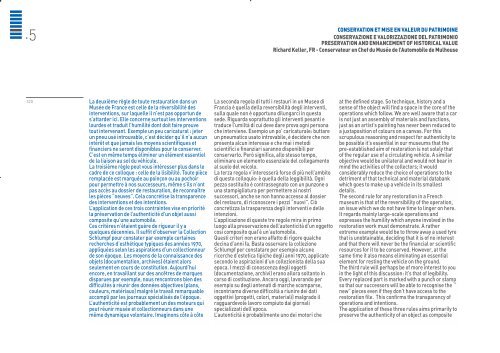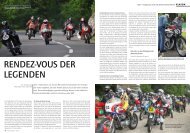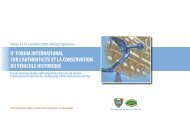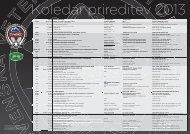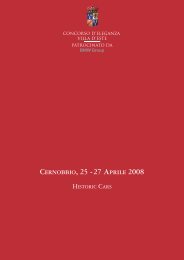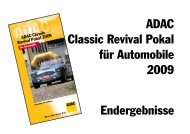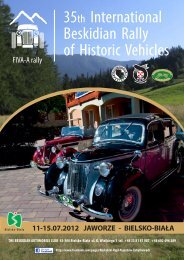FORUM INTERNATIONAL SUR L'AUTHENTICITE DU VEHICULE HISTORIQUE ...
FORUM INTERNATIONAL SUR L'AUTHENTICITE DU VEHICULE HISTORIQUE ...
FORUM INTERNATIONAL SUR L'AUTHENTICITE DU VEHICULE HISTORIQUE ...
You also want an ePaper? Increase the reach of your titles
YUMPU automatically turns print PDFs into web optimized ePapers that Google loves.
.5<br />
120<br />
La deuxième règle de toute restauration dans un<br />
Musée de France est celle de la réversibilité des<br />
interventions, sur laquelle il n’est pas opportun de<br />
s’attarder ici. Elle concerne surtout les interventions<br />
lourdes et traduit l’humilité dont doit faire preuve<br />
tout intervenant. Exemple un peu caricatural : jeter<br />
un pneu usé introuvable, c’est décider qu’il n’a aucun<br />
intérêt et que jamais les moyens scientifiques et<br />
financiers ne seront disponibles pour le conserver.<br />
C’est en même temps éliminer un élément essentiel<br />
de la liaison au sol du véhicule.<br />
La troisième règle peut vous intéresser plus dans le<br />
cadre de ce colloque : celle de la lisibilité. Toute pièce<br />
remplacée est marquée au poinçon ou au pochoir<br />
pour permettre à nos successeurs, même s’ils n’ont<br />
pas accès au dossier de restauration, de reconnaître<br />
les pièces “neuves”. Cela concrétise la transparence<br />
des interventions et des intentions.<br />
L’application de ces trois contraintes vise en priorité<br />
la préservation de l’authenticité d’un objet aussi<br />
composite qu’une automobile.<br />
Ces critères n’étaient guère de rigueur il y a<br />
quelques décennies. Il suffit d’observer la Collection<br />
Schlumpf pour constater par exemple certaines<br />
recherches d’esthétique typiques des années 1970,<br />
appliquées selon les aspirations d’un collectionneur<br />
de son époque. Les moyens de la connaissance des<br />
objets (documentation, archives) étaient alors<br />
seulement en cours de constitution. Aujourd’hui<br />
encore, en travaillant sur des ancêtres de marques<br />
disparues par exemple, nous rencontrons bien des<br />
difficultés à réunir des données objectives (plans,<br />
couleurs, matériaux) malgré le travail remarquable<br />
accompli par les journaux spécialisés de l’époque.<br />
L’authenticité est probablement un des moteurs qui<br />
peut réunir musée et collectionneurs dans une<br />
même dynamique volontaire. Imaginons côte à côte<br />
CONSERVATION ET MISE EN VALEUR <strong>DU</strong> PATRIMOINE<br />
CONSERVAZIONE E VALORIZZAZIONE DEL PATRIMONIO<br />
PRESERVATION AND ENHANCEMENT OF HISTORICAL VALUE<br />
Richard Keller, FR - Conservateur en Chef du Musée de l’Automobile de Mulhouse<br />
La seconda regola di tutti i restauri in un Museo di<br />
Francia è quella della reversibilità degli interventi,<br />
sulla quale non è opportuno dilungarci in questa<br />
sede. Riguarda soprattutto gli interventi pesanti e<br />
traduce l’umiltà di cui deve dare prova ogni persona<br />
che interviene. Esempio un po’ caricaturale: buttare<br />
un pneumatico usato introvabile, è decidere che non<br />
presenta alcun interesse e che mai i metodi<br />
scientifici e finanziari saranno disponibili per<br />
conservarlo. Però significa, allo stesso tempo,<br />
eliminare un elemento essenziale del collegamento<br />
al suolo del veicolo.<br />
La terza regola v’interesserà forse di più nell’ambito<br />
di questo colloquio: è quella della leggibilità. Ogni<br />
pezzo sostituito è contrassegnato con un punzone o<br />
una stampigliatura per permettere ai nostri<br />
successori, anche se non hanno accesso al dossier<br />
del restauro, di riconoscere i pezzi “nuovi”. Ciò<br />
concretizza la trasparenza degli interventi e delle<br />
intenzioni.<br />
L’applicazione di queste tre regole mira in primo<br />
luogo alla preservazione dell’autenticità d’un oggetto<br />
così composito qual’è un’automobile.<br />
Questi criteri non erano affatto di rigore qualche<br />
decina d’anni fa. Basta osservare la collezione<br />
Schlumpf per constatare per esempio alcune<br />
ricerche d’estetica tipiche degli anni 1970, applicate<br />
secondo le aspirazioni d’un collezionista della sua<br />
epoca. I mezzi di conoscenza degli oggetti<br />
(documentazione, archivi) erano allora soltanto in<br />
corso di costituzione. Ancora oggi, lavorando per<br />
esempio su degli antenati di marche scomparse,<br />
incontriamo diverse difficoltà a riunire dei dati<br />
oggettivi (progetti, colori, materiali) malgrado il<br />
ragguardevole lavoro compiuto dai giornali<br />
specializzati dell’epoca.<br />
L’autenticità è probabilmente uno dei motori che<br />
at the defined stage. So technique, history and a<br />
sense of the object will find a space in the core of the<br />
operations which follow. We are well aware that a car<br />
is not just an assembly of materials and functions,<br />
just as an artist’s painting has never been reduced to<br />
a juxtaposition of colours on a canvas. For this<br />
scrupulous reasoning and respect for authenticity to<br />
be possible it’s essential in our museums that the<br />
pre-established aim of restoration is not solely that<br />
of the regular use of a circulating vehicle. A similar<br />
objective would be unilateral and would not bear in<br />
mind the activities of the collectors; it would<br />
considerably reduce the choice of operations to the<br />
detriment of that technical and material databank<br />
which goes to make up a vehicle in its smallest<br />
details.<br />
The second rule for any restoration in a French<br />
museum is that of the reversibility of the operation,<br />
an issue which we do not have time to linger on here.<br />
It regards mainly large-scale operations and<br />
expresses the humility which anyone involved in the<br />
restoration work must demonstrate. A rather<br />
extreme example would be to throw away a used tyre<br />
that is unobtainable, deciding that it is of no interest<br />
and that there will never be the financial or scientific<br />
resources for it to be conserved. However, at the<br />
same time it also means eliminating an essential<br />
element for resting the vehicle on the ground.<br />
The third rule will perhaps be of more interest to you<br />
in the light of this discussion: it’s that of legibility.<br />
Every replaced part is marked with a punch or stamp<br />
so that our successors will be able to recognise the “<br />
new” pieces even if they don’t have access to the<br />
restoration file. This confirms the transparency of<br />
operations and intentions.<br />
The application of these three rules aims primarily to<br />
preserve the authenticity of an object as composite


